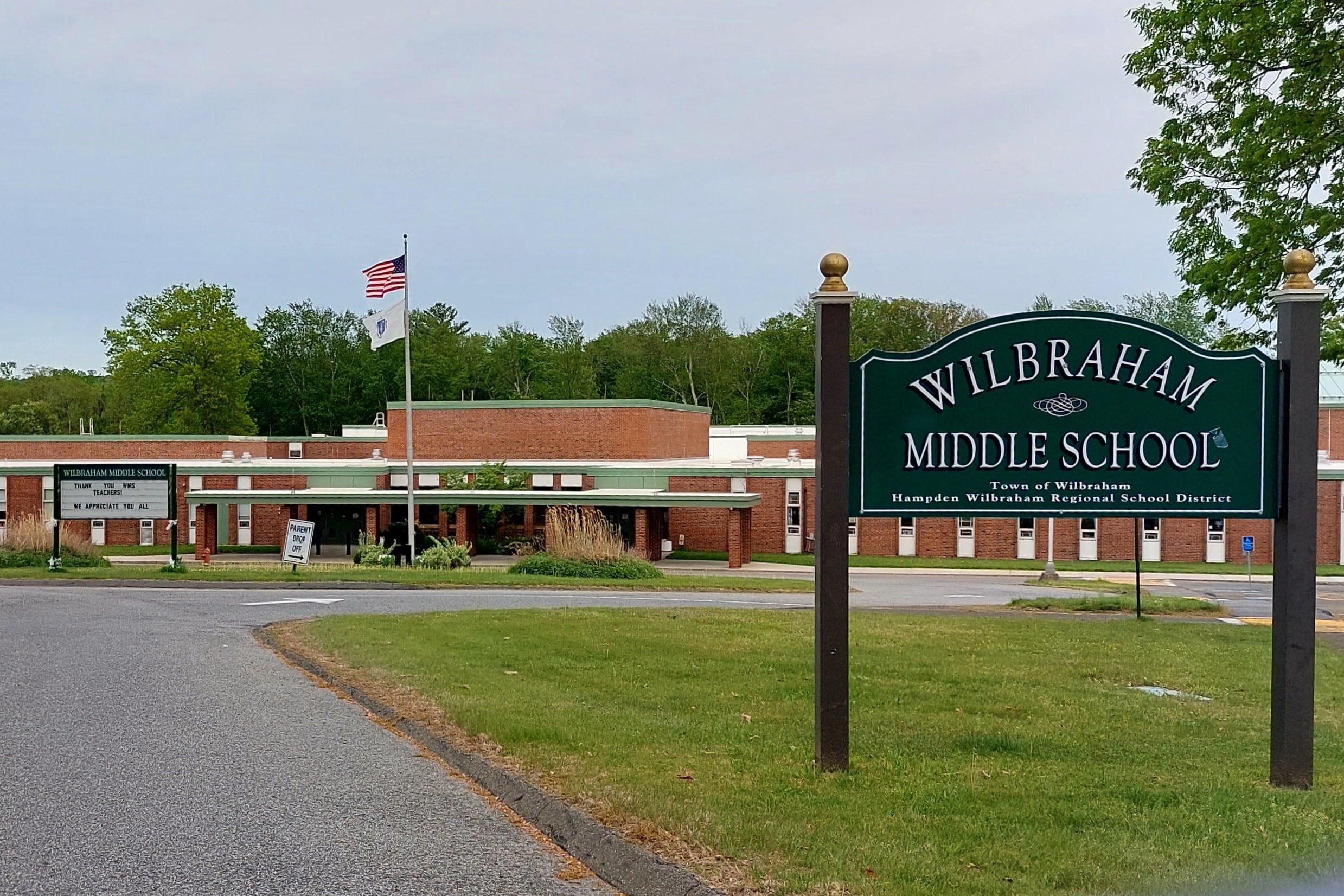HAMPDEN — The Hampden Selectboard and Wilbraham Select Board met on March 19 to discuss a major sticking point in updating the regional agreement governing the Hampden-Wilbraham Regional School District: who will pay for upgrades at the middle school?
Drafted revisions to the regional agreement state that grades 6-12 are regional and that any building which houses all students in those grades educated within the district is to be treated as a regional school. Wilbraham Middle School, which all middle school students attend, is owned by Wilbraham and leased to the district. As such, the town is responsible for the capital costs for that property. However, the capital costs for regional schools, such as Minnechaug Regional High School, are split in proportion to each town’s share of enrollment.
Hampden Selectboard Chair Donald Davenport began the meeting, which was conducted at Hampden’s Town House, by laying out possible solutions to the issue. The first would be to maintain the middle school as Wilbraham’s property and responsibility. Second, the school could continue to be owned by Wilbraham but treated as a district school with the capital costs split as they are for Minnechaug.
Alternatively, the property’s capital costs could be split, with “carve-outs” for what Davenport called “pre-existing conditions.” He cited a 2015 feasibility study that noted certain improvements that would need to be made for the property to become a regional school. As a final option, Davenport said the district could sell the building to the district for $1 and the towns could split the capital costs as they do for Minnechaug.
Davenport spoke about the closure of Thornton W. Burgess School. He said it was unfair to Hampden students “who were forced to go outside of their town to go to school” and to Wilbraham students “because they were already in an overcrowded school” and unfair to educators and administrators. Wilbraham Select Board Chair Susan Bunnell pushed back on the idea that Hampden students were “forced,” saying many Hampden parents chose to send their children to Wilbraham Middle School to ensure they had a “middle school experience.”
Hampden Selectboard member John Flynn attempted to move the conversation forward, asking, “Here we are in 2025, where do we go from here?” Flynn noted that Hampden already contributes to the building’s maintenance through the operational budget. He called the towns “partners.”
Bunnell said she has been trying to consider the situation as if Wilbraham were in Hampden’s position.
Flynn said the list of future capital needs depends to some extent on the possibility of building a new middle school. While he said, “nothing is off the table,” he also said the focus is on the existing school. He noted improvements made by Wilbraham, replacing the roof a few years ago.
“We’re not looking to turn this building into the Taj Mahal at this stage, we want to make sure the kids are safe and that the building is safe,” Bunnell said. She asked rhetorically, “How much do any of us” want to “be putting into a building that may not have much of a future?” Everyone agreed that any new school would be at least a decade away.
Bunnell mentioned the mold issue at the beginning of the 2024-25 school year. Hampden Selectboard member Craig Rivest asked if the school had been tested for mold since the remediation. Bunnell said it was tested over the winter.
Wilbraham Select Board member Mark Ducey said the door hardware needs replacing and noted that students could potentially lock a teacher out of a classroom. Flynn noted that it was an issue at Green Meadows School, as well, and was a safety concern in an emergency. However, he said the problem would be present whether Hampden students were in the school or not and it was part of “building upgrades that have been kicked down the road for several years.”
Bunnell acknowledged that and said the towns can “come to an agreement” about what items need to be addressed. She said the district has been making recommendations to the town’s Capital Planning Committee, just as they do with Hampden.
“Just so we’re clear and everybody knows, the reason for this meeting is that Wilbraham is looking for financial help from Hampden for repairing facilities at Wilbraham Middle?” Rivest asked.
Bunnell began saying that if the school became a regional building, Wilbraham would want the towns to split costs. Rivest interjected, “So only if it becomes a regional building?” Bunnell responded that she did not see how it could not if it is the only school in the district that middle schoolers attend.
Ducey said the regional agreement as drafted specifies that a regional middle school would be split by enrollment. He said, “We’re OK with it. Seemingly, Hampden’s not.”
Return on investment
Rivest said taxpayers have told him they are concerned about investing in a building they do not own. “The only thing that I can see possibly working out that would be fair is if Hampden had an equity stake in the building,” he said, later adding, “We could invest in the tires for [a] vehicle or the new paint job, but at the end of the day, if somebody was to sell that vehicle, we’re not returning our investment.” Referred to the idea of selling the building to the district “for a dollar,” and said both towns would then have a stake in the building as members of the district.
Ducey said selling the building for $1 was a “non-starter.”
Bunnell said Wilbraham would be giving up 20% of the value of the building. “I don’t see how that’s fair,” she said, adding, “Your return on investment is making sure your kids are educated in a building that’s safe.” Rivest countered, “That’s the state law.”
Flynn provided as an example the boiler that recently failed at Minnechaug. He said, “If something like that happens at the middle school, you bill us 19%, down the road, we should get some return for that money” should the school be sold later.
When asked by Bunnell, Rivest clarified that Hampden would only be seeking their portion of the value added to the property by the capital improvements it had helped make.
“We need to move forward as a single district and I think to do that, we have to recognize that both sides are going to take some kind of an uncomfortable loss if we look at it strictly as a financial decision,” said Wilbraham Select Board member Michael Squindo. Instead, he recalled Bunnell’s earlier statement that the return on investment is in the safety and education of the children. He said he did not want to risk the regional agreement over the issue. For his part, Squindo said he was leaning toward splitting the capital costs, with or without carve-outs.
Carve-outs
Flynn asked what upgrades would be considered as a capital cost. Ducey said the regional agreement determines what qualifies as a capital cost, but said if it were considered a capital cost at Minnechaug, it would be at the middle school, as well. However, Flynn said the high school was built as a regional school and that there is a difference between educational materials or technology and “the brick and mortar that existed for 70 years prior to being used in a regional application.”
Returning to the topic of “pre-existing conditions,” Davenport said the 2015 feasibility study called out repairs that needed to be undertaken to make the building a regional school. He said those repairs had not been done. Bunnell reminded him that the roof had been replaced.
“Why are we paying for something that should have been taken care of when [the school] consolidated?” Davenport asked. Squindo responded, “Why are any capital projects not done? It’s a priority conversation.” When Davenport said, “You’re not taking care of your building,” Squindo pushed back and said that was not a fair characterization. He said the towns have limited resources. He said, “It’s not us deferring it because we think, ‘Eh, we’ll wait until we regionalize the middle school.’”
Wilbraham has put $1.8 million into the school since 2026, Bunnell said, commenting, “That’s not nothing.”
Davenport said, “The Wilbraham kids are sitting in the same damn school, with the mold, with the bad windows, with the bad doors, with the bad toilets.” He added, “It’s unfair to the Wilbraham kids, too.” Bunnell said the mold is no longer an issue according to the state, but Davenport responded that the mold had been a known issue for 10 years. He repeated, “Why are we paying for it now and getting nothing in return down the road.”
Ducey asked, “What can we do to move forward?” He noted that any capital projects would need to be approved by both towns. “We don’t have any assurances that Hampden’s going to make these repairs,” he said.
“Or Wilbraham,” countered Flynn. Ducey acknowledged, “Fair point.”
Davenport said in 2016 when an article went to town meeting for a vote on regionalizing the school, Wilbraham carved out the roof. He wanted to know what could be carved out now. In the same vein, Flynn questioned whether the air filtration upgrades that are currently needed are the result of the mold problem.
“The building is 70 years old, there’s going to be a lot of pre-existing conditions,” Ducey said. Bunnell said the Capital Planning Committee had not yet finalized a list of fiscal year 2026 projects.
Rivest asked what Wilbraham is looking for from Hampden. Bunnell restated the regional agreement draft’s position on the school’s capital expenses being split.
“That’s because you’re allowing our students into your building.” Rivest stated. Bunnell responded, “We’ve welcomed your students.”
Flynn said there are seven months to hammer the details out before the towns’ fall Town Meetings when the regional agreement will come to a vote. The next meeting between the board is scheduled for April 2.



